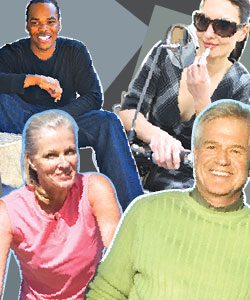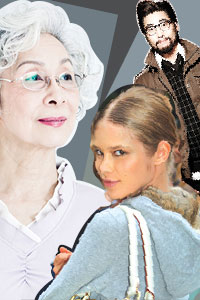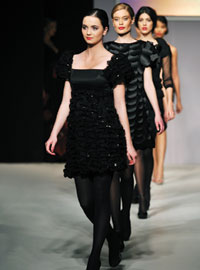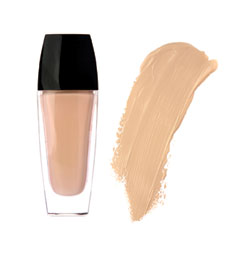Do Guys Not Age As Fast Because They Dont Wear Makeup Etc
 There's no getting around it. In this world, you're better off being good-looking. At all ages and in all walks of life, attractive people are judged more favorably, treated better, and cut more slack. Mothers give more than amore to attractive babies. Teachers favor more than bonny students and guess them as smarter. Attractive adults get paid more for their piece of work and have better success in dating and mating. And juries are less likely to find attractive people guilty and recommend lighter punishments when they practice.
There's no getting around it. In this world, you're better off being good-looking. At all ages and in all walks of life, attractive people are judged more favorably, treated better, and cut more slack. Mothers give more than amore to attractive babies. Teachers favor more than bonny students and guess them as smarter. Attractive adults get paid more for their piece of work and have better success in dating and mating. And juries are less likely to find attractive people guilty and recommend lighter punishments when they practice.
Many factors can play into personal attractiveness — the way yous dress, the way y'all human action, the way you carry yourself, fifty-fifty things that are difficult or impossible to change, like social status and wealth, race, and body size and shape. But the first thing we observe when we run into someone is their face. There are faces that launch a one thousand ships, and faces that only a mother could love, and we are supremely attuned to tell the difference. The brain, among its many other functions, is a dazzler detector.
The encephalon is such a proficient dazzler detector, in fact, that it can estimate the appeal of a confront before y'all're enlightened you lot've fifty-fifty seen one. When participants in a recent report were presented with attractive and unattractive faces for only 13 milliseconds, they were able to judge the faces' attractiveness accurately (that is, in accordance with experimenters' ratings), even though they were not consciously aware of the stimuli and felt like they were simply guessing (Olson & Marshuetz, 2005).
In that location is no dubiousness that beauty (which hither means both male and female attractiveness) is to some extent in the eye of the beholder, only across individuals and beyond cultures there is nevertheless considerable agreement nearly what makes a pretty or handsome face, and the evidence strongly counters the conventional wisdom that bewitchery preferences are mainly acquired through life experience. For one thing, the beauty bias is already present in infancy. Half dozen-month-olds prefer to look at the same relatively attractive faces that adults exercise (Rubenstein, Kalakanis, & Langlois, 1999).
Truth in Beauty
The question is, is dazzler really just skin deep, or does an attractive face up actually reverberate underlying good qualities? In a few ways, the stereotype that "beautiful is good" does hold. Evolutionary psychology holds that faces really are windows onto certain fundamental and important characteristics indicative of a person'south quality as a romantic partner and equally a mate — qualities of health and genes, and fifty-fifty grapheme.
 Among the most important and consequent factors in facial attractiveness are structural qualities of the face up that are highly sexual practice-typical. An attractive homo, in the optics of female person experimental participants, is generally ane with relatively prominent cheekbones and eyebrow ridges and a relatively long lower confront. Too, prominent cheekbones, big eyes, small nose, a taller forehead, smooth pare, and an overall immature or fifty-fifty artless appearance add to women'south allure in the eyes of male raters.
Among the most important and consequent factors in facial attractiveness are structural qualities of the face up that are highly sexual practice-typical. An attractive homo, in the optics of female person experimental participants, is generally ane with relatively prominent cheekbones and eyebrow ridges and a relatively long lower confront. Too, prominent cheekbones, big eyes, small nose, a taller forehead, smooth pare, and an overall immature or fifty-fifty artless appearance add to women'south allure in the eyes of male raters.
Our faces are sculpted by our hormones. These sexual practice-typical facial features of adult men and women reflect the ratio of testosterone to estrogen or estrogen to testosterone, respectively, acting on the individual during development. Nosotros are programmed to be fatigued to stiff indicators of maleness (for women) and femaleness (for men) partly considering they reflect an individual's health (Fink & Penton-Voak, 2002). The reason hormones equate to health is somewhat counterintuitive. High levels of sex hormones during puberty really suppress the allowed system, raising vulnerability to illness and infection. It sounds like a bad thing. But when a person with a particularly "male" or "female person" face makes it to machismo with all his or her wellness intact, it means that the person has withstood the potentially debilitating influence of those high hormones. In other words information technology signifies a more robust constitution.
'Your Symmetry Lights Up the Room'
No two faces are akin, and no two halves of a face are alike. Countless small variables make faces somewhat asymmetrical – a slightly wider jaw on one side, one eye a fraction of an inch lower than the other, a cheekbone that sticks out merely a wee bit more than, a dimple on one cheek, etc. Some asymmetries (called directional asymmetries) are common beyond the population – for instance, the left side of virtually people'due south faces is slightly larger than the right. But many asymmetries, called fluctuating asymmetries, ascend when one'due south unfolding genetic plan is perturbed during evolution, for case by parasites or other environmental challenges. The slings and arrows of life's fortunes tin literally knock our faces off of kilter, merely similar a punch to the nose. A symmetrical face up, like a particularly masculine or feminine one, is a sign of having stood upwardly ameliorate to life's figurative schoolyard beatings.
Numerous studies accept found that when men and women are asked to compare versions of faces that are more than versus less symmetrical, the symmetrical ones garner significantly college ratings of attractiveness, authorization, sexiness, and wellness, and are perceived to be more desirable as potential mates (Rhodes, Proffitt, Grady, & Sumich, 1998; Shackelford & Larsen, 1997). And so every bit with masculine/feminine features, the entreatment of symmetry makes perfect sense to evolutionary psychologists. In a cute face, we are actually seeing the artistry of good genes. People prefer symmetrical faces even when they can't really perceive the symmetry – that is, when only face up halves are presented. It may be that symmetry covaries with other desirable characteristics that reflect the same genetic endowment and overall health (Penton-Voak et al., 2001).
It may not exist all that surprising that nosotros'd rather mate with a symmetrical Greek god or goddess than with someone who stepped out of a Picasso painting. Less obvious is that a pretty or handsome face is also generally 1 that is, well, average. When presented with individual faces and a blended of those private faces, participants volition guess the composite as more than attractive than the private, more than distinctive faces. And the more faces that contribute to the composite, the more attractive it becomes (Langlois & Roggman, 1990). The most bonny faces appear to be those whose features are closest to the average in the population—that is, more prototypical.
Averageness, like symmetry, reflects a favorable genetic endowment. Those with average features are less likely to be conveying harmful mutations. Additionally, averageness reflects greater heterozygosity — having both a dominant and a recessive allele for given traits, rather than two dominant or two recessive alleles (an reward that symmetry also reflects). Heterozygosity confers relatively greater resistance to pathogens, in many cases, and thus, along with all the other indicators of resilience, nosotros may be programmed to seek information technology out through its subtle but telltale signs.
Withal, it has too been argued that in that location may be some much simpler cognitive reasons for the preference for averages. Likewise faces, people show a preference for boilerplate-looking dogs, average-looking birds, and average-looking watches (Halberstadt & Rhodes, 2000). Prototypes are more familiar-looking than less typical examples of a given course of objects, be information technology the face of a potential mate or the face of a timepiece, and they are easier to process. Easy on the eyes = easy on the brain.
 In the Sex of the Beholder
In the Sex of the Beholder
Men and women both evidence the to a higher place preferences when it comes to faces, only in general men's preferences tend to be more pronounced (Rhodes et al., 1998). Males may place greater importance on physical beauty when information technology comes to mate choice, while females too attend to characteristics like power and condition. But a number of factors contribute to how much — and when — male person face up characteristics matter to women.
One factor is a woman's ain attractiveness: Preference for masculine and symmetrical features has been shown to be higher for women who regard themselves every bit more attractive (Little, Burt, Penton-Voak, & Perrett, 2001). Another is time of the month: The degree of women's preferences for unlike attractive qualities fluctuates strikingly beyond the ovulatory cycle.
A group of University of Mexico psychologists accept studied women's shifting preferences for symmetrical men. They have constitute that this preference (which women can not only see, but even smell in tee-shirts slept in by symmetrical men) increases dramatically around the fourth dimension of ovulation, when a woman is well-nigh fertile and the risk of formulation is highest (Gangestad, Thornhill, & Garver-Apgar, 2005). And then does a adult female's preference for more masculine-looking men. But this preference wanes during other times of the calendar month. Again, evolutionary psychology provides a ready caption.
Humans, similar many other species, are socially monogamous but not necessarily sexually monogamous. When sexual activity might upshot in getting meaning, it's health and fertility that are specially desirable in a mate. But good genes in the sense of physical wellness is not the aforementioned as practiced genes in the sense of character, and what makes a expert sperm donor may not make the best long-term, nurturing, helpful life partner. The flip side of high testosterone is an increased tendency toward assailment and antisocial beliefs, a trend to compete rather than help. Thus a male with less testosterone, indicated past less masculine features, may invest more in caring for offspring (whether or non he'southward the biological begetter) and and so may be better to take around for the long term.
A G Ships
 In myth, beautiful women are confusing of men's reason, even causing them to become to state of war. We at present know that there's truth to the idea that men brand worse decisions when exposed to female beauty, and we even are beginning to understand the neural ground. A pair of McMaster University researchers establish that looking at photographs of bonny women (simply non unattractive women) acquired a significant increase in filibuster discounting in men — that is, choosing a smaller immediate reward over a larger delayed one (Wilson & Daly, 2004). Information technology'southward the same tendency found to a loftier degree in addicts and others with impaired self-control. Interestingly, viewing attractive men did not influence women's decisions.
In myth, beautiful women are confusing of men's reason, even causing them to become to state of war. We at present know that there's truth to the idea that men brand worse decisions when exposed to female beauty, and we even are beginning to understand the neural ground. A pair of McMaster University researchers establish that looking at photographs of bonny women (simply non unattractive women) acquired a significant increase in filibuster discounting in men — that is, choosing a smaller immediate reward over a larger delayed one (Wilson & Daly, 2004). Information technology'southward the same tendency found to a loftier degree in addicts and others with impaired self-control. Interestingly, viewing attractive men did not influence women's decisions.
The reason-unseating effect of a beautiful face partly involves the amygdala. Activation of the amygdala, which detects the value of social stimuli, has been associated with greater discounting of all kinds of future rewards, and certain enough, this brain expanse shows much stronger activation to attractive faces than to more than boring ones. (Information technology is really a U-shaped relationship; the amygdala is also highly activated by unattractive faces; Winston, O'Doherty, Kilner, Perrett, & Dolan, 2007.)
In both men and women, attractive faces cause greater activation in several other brain areas involved in processing of rewards. These include the nucleus accumbens, which likewise activates in response to rewarding stimuli similar coin; the medial prefrontal cortex; and the anterior cingulate cortex, which may be involved in shaping future beliefs from learning reward outcomes. In men (but non in women), the orbitofrontal cortex, an surface area that evaluates the reward value of current behaviors, also activates in response to bonny female faces (Cloutier, Heatherton, Whalen, & Kelley, 2008).
Beautify Yourself
Dazzler is unfair. Not everyone tin can be built-in with cracking genes. Not everyone can be born symmetrical. Not anybody can be built-in enticingly, well, average. But obviously there are many factors contributing to bewitchery that are potentially under our control.
For women, makeup does  take a strong event. In one report, women wearing makeup were approached more, and approached faster, by men at a bar than they were on nights without makeup (Gueguen, 2008b). Effect sizes on dazzler judgments for makeup have been establish to be as high equally those for the facial structural features mentioned earlier (Osborn, 2006).
take a strong event. In one report, women wearing makeup were approached more, and approached faster, by men at a bar than they were on nights without makeup (Gueguen, 2008b). Effect sizes on dazzler judgments for makeup have been establish to be as high equally those for the facial structural features mentioned earlier (Osborn, 2006).
Getting enough beauty slumber is something everyone can exercise to upwardly their beauty quotient. A group of Swedish and Dutch researchers conducted an experiment in which observers rated the attractiveness (besides every bit health) of participants who were photographed both after a menstruation of sleep impecuniousness and after a practiced night's sleep (Axelsson, 2010). Not surprisingly, individuals who were sleep deprived were rated significantly less attractive than those who were rested. They were also rated less healthy.
And then there are the emotions we project through our faces. Not surprising, positive emotions increase attractiveness. We are fatigued to those who grin, for example. As when they wore makeup, women who smiled at men on entering a bar were more likely to be approached and were judged more favorably (Gueguen, 2008a). Even a smile perceived just in the periphery of one's vision will exist seen as more than attractive than a face up with a neutral expression (Bohrn, Carbon, & Hutzler, 2010). And attractive faces that smile produce fifty-fifty more action in the orbitofrontal cortex than practise bonny faces wearing neutral expressions (O'Doherty et al., 2003).
So hither's the timeless message of psychological science: Be beautiful—or, as beautiful as you can. Smile and sleep and practise whatever else y'all tin practice to make your face a reward. Amidst its other social benefits, attractiveness actually invites people to larn what yous are made of, in other respects than only genetic fitness. According to a new study at the Academy of British Columbia (Lorenzo, Biesanz, & Human, 2010), attractive people are actually judged more accurately—at least, closer to a field of study's own self-assessments—than are the less attractive, because information technology draws others to go beyond the initial impression. "People do judge a book by its encompass," the researchers write, "simply a beautiful cover prompts a closer reading." œ
References
Axelsson, J., Sundelin, T., Ingre, M., Van Someren, Due east.J.W., Olsson, A., & Lekander, Yard. (2010). Dazzler sleep:
Experimental study on the perceived health and bewitchery of sleep deprived people [online version].
British Medical Journal, 341. doi: 10.1136/bmj.c6614
Bohrn, I., Carbon, C.-C., & Hutzler, F. (2010). Mona Lisa'due south grinning—Perception or charade? Psychological
Science, 21, 378–380.
Cloutier, J., Heatherton, T.F., Whalen, P.J., & Kelley, W.Yard. (2008). Are bonny people rewarding? Sex
differences in the neural substrates of facial bewitchery.
Fink, B., & Penton-Voak, I. (2002). Evolutionary psychology of facial bewitchery. Current Directions in
Psychological Science, 11, 154–158.
Gangestad, South.W., Thornhill, R., & Garver-Apgar (2005). Adaptations to ovulation: Implications for sexual and
social behavior. Current Directions in Psychological Science, 14, 312–316.
Gueguen, Due north. (2008a). The effect of a adult female's grinning on men'southward courtship behavior. Social Behavior and
Personality, 36, 1233–1236.
Gueguen, N. (2008b). The effects of women'due south cosmetics on men's arroyo: An evaluation in a bar. North
American Journal of Psychology, 10, 221–228.
Halberstadt, J., & Rhodes, G. (2000). The attractiveness of nonface averages: Implications for an evolutionary
explanation of the attractiveness of average faces. Psychological Science, 11, 285–289.
Haselton, M.G. & Gildersleeve, Grand. (in press). Can men detect ovulation? Current Directions in Psychological
Science.
Langlois, J.H., & Roggman, L.A. (1990). Attractive faces are just average. Psychological Scientific discipline, 1, 115–121.
Lilliputian, A.C., Burt, D.Thou., Penton-Voak, I.Due south., & Perrett, D.I. (2001). Self-perceived attractiveness influences homo
female person preferences for sexual dimorphism and symmetry in male person faces. Proceedings of the Majestic Society of London B: Biological Sciences, 268, 39–44.
Lorenzo, G.Fifty., Biesanz, J.C., & Human being, 50.J. (2010). What is beautiful is good and more accurately understood:
Concrete attractiveness and accuracy in first impressions of personality. Psychological Scientific discipline, 21,
1777–1782.
O'Doherty, J., Winston, J., Critchley, H., Perrett, D., Burt, D.Thou. (2003). Dazzler in a smile: The role of medial
orbitofrontal cortex in facial bewitchery. Neuropsychologia, 41, 147–155.
Olson, I.R., & Marshuetz, C. (2005). Facial attractiveness is appraised in a glance. Emotion, 5, 498–502.
Osborn, D.R. (2006). Beauty is as beauty does? Makeup and posture effects on concrete attractiveness
judgments. Periodical of Applied Social Psychology, 26, 31–51.
Penton-Voak, I.S., Jones, B.C., Trivial, A.C., Baker, S., Tiddeman, B., Burt, D.M., & Perrett, D.I. (2001).
Symmetry, sexual dimorphism in facial proportions and male facial bewitchery. Proceedings of the
Imperial Club: Biological Sciences, 268, 1617–1623.
Rhodes, G., Proffitt, F., Grady, J.Thou., & Sumich, A. (1998). Facial symmetry and the perception of beauty.
Psychonomic Bulletin & Review, 5, 659–669.
Rubenstein, A.J., Kalakanis, L., & Langlois, J.H. (1999). Baby preferences for attractive faces: A cognitive
explanation. Developmental Psychology, 35, 848–855.
Shackelford, T. K., & Larsen, R. J. (1997). Facial asymmetry as an indicator of psychological, emotional,and
physiological distress. Journal of Personality and Social Psychology, 72, 456–466.
Wilson, Grand., & Daly, M. (2004). Do pretty women inspire men to discount the future? Proceedings of the Purple
Society of London B, 271(Suppl.), S177–S179.
Winston, J.S., O'Doherty, J., Kilner, J.M., Perrett, D.I., & Dolan, R.J. (2007). Brain systems for assessing facial
bewitchery. Neuropsychologia, 45, 195–206.
Source: https://www.psychologicalscience.org/observer/beauty-is-in-the-mind-of-the-beholder
Posted by: youngallind.blogspot.com

0 Response to "Do Guys Not Age As Fast Because They Dont Wear Makeup Etc"
Post a Comment